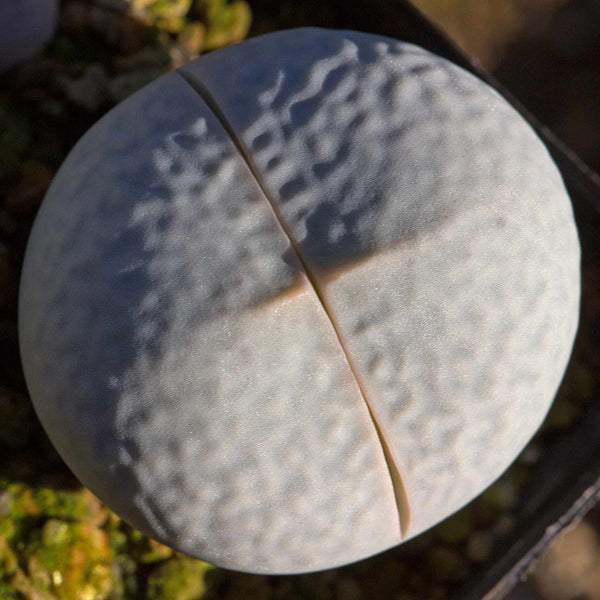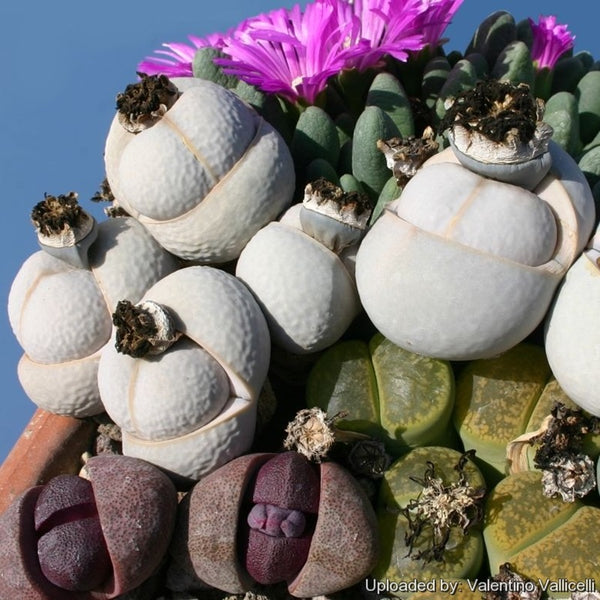Dinteranthus pole-evansii (Golf Ball Plant) - 20 seeds
Regular price
$7.99
Dinteranthus pole-evansii grows in very dry areas on the Nama Karoo deserts, on sandy soils associated with quartz stones and pebbles. It mimics the chalky-white quartz pebbles of its background. It is a solitary or clumping species with chalky white bodies that look like golf balls. This particular species has a rough surface and is one of the most attractive of the 'stemless' mesembs and very priced by collectors.
HOW TO GROW?
The small seeds can be sown in pots of fine, well-drained sand any time during the spring and summer months when temperatures are warm. Seeds require high temperatures for germination. Cover the seeds with a very fine layer of grit and water from below with a fungicide to prevent damping off. For the first 3-4 days, cover the pots with a sheet of glass/clear perspex to keep the humidity levels high. Remove the glass and replace it with a light shade-cloth and mist once or twice a day for the next two weeks, after which most seeds should have germinated. From then on, mistings can be reduced to every second and then every third day as the little plants grow.
Dinteranthus pole-evansii are summer-growing species with a dry rest period over winter, but they do not show an apparent dormant season like Lithops. Paying attention to the particular growing requirement of Dinteranthus is especially important. If you provide the Dinteranthus with the right conditions, they will reward you with their unique shape, size, color, and a proliferation of blooms in autumn. However, Dinteranthus are tricky plants that are very particular about their growing conditions and require the right maintenance in order to keep them happy. But don't be afraid, even the best growers have plants that mysteriously dry up or leave during the night. While Dinteranthus are picky about their care, if you are patient and remember the basics, your efforts will be rewarded. Being small plants, a representative collection can be grown on a patio table, a sunny windowsill, or a shelf in the greenhouse. Growing rate: Slow growing for a mesemb. Soil: Easy to grow, they need a very open mineral, fast draining mix with little compost and a high degree of grit, coarse sand, small lava gravel, or pebbles. They can grow outdoor in sunny, dry rock crevices (protection against winter wet is required). They can also be cultivated in an alpine house, in poor, drained soil.
HOW TO GROW?
The small seeds can be sown in pots of fine, well-drained sand any time during the spring and summer months when temperatures are warm. Seeds require high temperatures for germination. Cover the seeds with a very fine layer of grit and water from below with a fungicide to prevent damping off. For the first 3-4 days, cover the pots with a sheet of glass/clear perspex to keep the humidity levels high. Remove the glass and replace it with a light shade-cloth and mist once or twice a day for the next two weeks, after which most seeds should have germinated. From then on, mistings can be reduced to every second and then every third day as the little plants grow.
Dinteranthus pole-evansii are summer-growing species with a dry rest period over winter, but they do not show an apparent dormant season like Lithops. Paying attention to the particular growing requirement of Dinteranthus is especially important. If you provide the Dinteranthus with the right conditions, they will reward you with their unique shape, size, color, and a proliferation of blooms in autumn. However, Dinteranthus are tricky plants that are very particular about their growing conditions and require the right maintenance in order to keep them happy. But don't be afraid, even the best growers have plants that mysteriously dry up or leave during the night. While Dinteranthus are picky about their care, if you are patient and remember the basics, your efforts will be rewarded. Being small plants, a representative collection can be grown on a patio table, a sunny windowsill, or a shelf in the greenhouse. Growing rate: Slow growing for a mesemb. Soil: Easy to grow, they need a very open mineral, fast draining mix with little compost and a high degree of grit, coarse sand, small lava gravel, or pebbles. They can grow outdoor in sunny, dry rock crevices (protection against winter wet is required). They can also be cultivated in an alpine house, in poor, drained soil.




